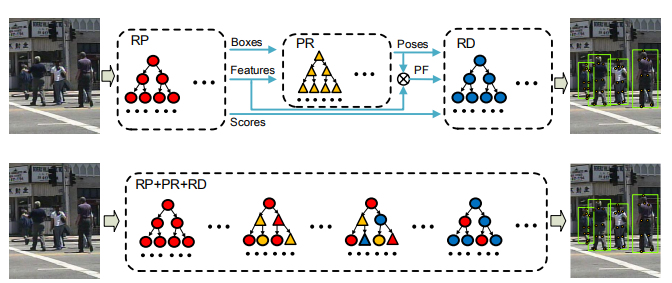- ALL COMPUTER, ELECTRONICS AND MECHANICAL COURSES AVAILABLE…. PROJECT GUIDANCE SINCE 2004. FOR FURTHER DETAILS CALL 9443117328


Projects > ELECTRONICS > 2020 > IEEE > DIGITAL IMAGE PROCESSING
Pedestrian detection with high detection and localization accuracy is increasingly important for many practical applications. Due to the flexible structure of the human body, it is hard to train a template-based pedestrian detector that achieves a high detection rate and a good localization accuracy simultaneously. In this paper, we utilize human pose estimation to improve the detection and localization accuracy of pedestrian detection. We design two kinds of pose-indexed features that can considerably improve the discriminability of the detector. In addition to employing a two-stage pipeline to carry out these two tasks, we unify pose estimation and pedestrian detection into a cascaded decision forest in which they can cooperate sufficiently. To prevent irregular positive examples, such as truncated ones, from distracting the pedestrian detection and the pose regression, we clean the positive training data by realigning the bounding boxes and rejecting the wrong positive samples. Experimental results on the Caltech test dataset demonstrate the effectiveness of our proposed method. Our detector achieves 11.1% MR?2, outperforming all existing detectors without using the convolutional neural network (CNN).
Region proposal network (RPN) followed by boosted forests
The major contributions of this paper are as follows: 1) We propose a novel pedestrian detector utilizing human pose estimation to improve the localization accuracy and the detection rate. We unify the classification of positive/negative samples and the regression of human pose in a decision forest framework. Based on the estimated human pose, we propose two new types of pose-indexed features: joint-indexed features and symmetry-indexed features. 2) The positive training samples are purified with the help of human pose regression. The estimated human poses are used to reject wrong annotations and re-align inaccurate annotations. With the help of improved annotations, the localization accuracy of detectors increases. 3) The joints of pedestrians on a subset of Caltech pedestrians are annotated to build a new pedestrian-joints dataset for further research, such as pedestrian action analysis and synthetic pedestrian data generation.
BLOCK DIAGRAM
